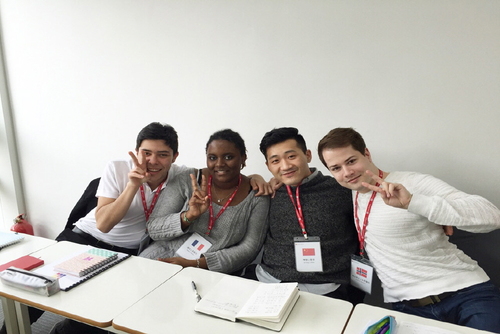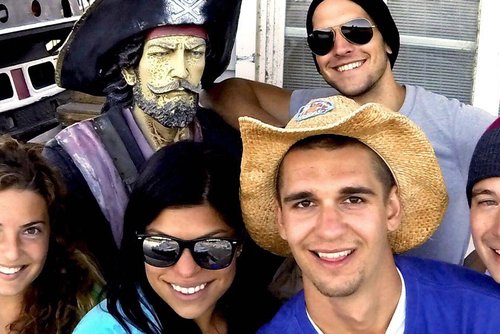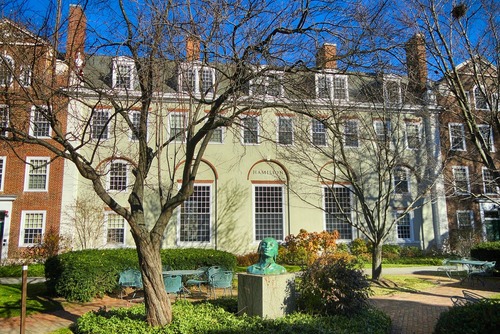But do you need perfect grades to get into an American college? Is education the same in all US states?
Check out this article where we check out common myths about studying in the US, including information about Ivy League universities, how much tuition costs, how to afford it and how to look for a job after graduation.
What misconceptions exist about higher education in the USA?
More than a million students from different countries currently study in the United States, about 5% of the total students. Every year, there are more and more foreigners applying.
Naturally, students from different countries are interested in the excellent tuition available in American colleges but some myths surround the US education system and this can put off many international students to consider looking for educational institutions in other countries.
This article will try to discover the truth and dispel false prejudices.
Myth 1: Higher education in the United States is only available to the rich
Going to university in America does cost a lot of money, but you don't have to be a millionaire to do it. Various financing options and bursaries are available even for people who are not US citizens or registered in the country.
Many US universities also offer scholarships to international students. Some awards are based on need (depending on financial status), while other scholarships are awarded without regard to economic conditions.
You also don’t need to have a lot of money to have a comfortable social life as costs for accommodation, food and entertainment is generally on a par with Australia, Canada and Europe for example.
Myth 2: The visa process is complicated.
The visa procedure for studying in the States is fairly simple but it does take time. In 2022, American educational institutions accepted approximately 1 million students from different countries. Once you are accepted, the university will send you an I-20.
You need to apply for a visa and schedule an interview. During personal communication, the expert will check your ability and desire to receive an education. You must explain how the training program meets your career development goals. After the interview, you will get an approval usually 5-6 days afterwwards.
Myth 3: Private colleges are more expensive than public colleges
When looking at prices, public colleges seem to be a more affordable option than private ones. However, other factors must be analyzed to determine the actual costs. For example, if you live in a state other than your college, attending a public school may cost several times more. In this case, it is better to find colleges offering more affordable tuition for talented out-of-state kids or lower prices for out-of-state people.
Myth 4: Only students with excellent grades are accepted to university
A 4.0 GPA may look impressive when applying to college, but other important factors are important. Don't forget about a creative essay, a good letter of recommendation, and a correct resume. Admissions teams at colleges and universities know that grades don’t always entirely reflect students' potential. They want to learn more about your life, strenghts, background and career goals.
Getting high grades is excellent, but they don't always get you into the best school due to the competition with places. Throughout the application process, you must demonstrate that you are the best candidate for admission to the college. Even if you weren't the best student in school, you can explain why in your essay.
For assurance that your application is well-written, you can turn to a paper writing service like Paperwritings.com for assistance. Try to demonstrate your strengths in other areas by doing well on the test and getting recommendations from your teacher.
Myth 5: Paying off student debt is impossible.
While it may seem problematic, creating a debt repayment plan while still in school can help you get out of debt faster.
Start early, such as taking a part-time job at university and using the money you receive to pay your fees. Create a budget and stick to it, or use a student budget calculator to keep track of your spending habits.
After completing your studies, if possible, transfer more than the specified minimum amount to repay the budget. Over time, larger payments will reduce your interest rate and debt service costs.
Myth 6: American universities are not welcoming to international students
Universities in the USA assign economic consultants to future students who will tell them about all the features of the local educational system, help them choose a course, etc. US campuses are constantly bustling with life. This creates a comfortable space for students from different countries to interact, gain new knowledge, and actively develop.
Universities value diversity and organize social and cultural events to make international visitors feel welcome. You can find colleges that strictly follow different traditions like Ramadan or Diwali. Some college towns have diverse student populations and neighborhoods that can help with integration when living abroad.
Myth 7: Ivy League universities are the only option
An Ivy League university isn’t always ideal for your major. Various private and public universities may offer a more balanced academic program in your chosen specialty than the conference school that interests you.
At the same time, Ivy League universities are known for their excellent academic programs, professional alumni networks, and high starting salaries. It is difficult to get into such educational institutions; most applicants (up to 85%) are rejected.
In addition, the high costs of obtaining an education at the most prestigious universities can lead to huge debts. This means that even if you earn more after graduation than non-Ivy students, you might actually spend more to repay your loans.
To find the best university, you need to consider different options. With many educational institutions, it can be helpful to consider whether Ivy league universities have the course you want or whether you might be better off looking at colleges in other states.
Myth 8: Finding a job after university in the USA is challenging
Finding an exciting job at a university can be difficult for anyone, but international students may face additional challenges. However, it is possible to find career paths.
You should think about trying to find internships as they can help you gain the necessary skills and a full-time job in the future. You must collect all the required information about visa methods, rules, and fees when looking for a job.
If you want to stay in the United States you will need to find recruiters which sponsor visas, eligibility, and how long the process takes. Talented young people from different countries work in the USA every year.
International students have two months after graduation to enroll in a new program, become participants in an Optional Practical Training (OPT) project, or find employment on an F-1 visa. You can continue your visa for 12 months if you qualify for OPT. During this period, you can work, undergo internships, or conduct research in your chosen scientific field.
Myth 9: Education is the same in all American states
Education in different regions of the United States is decentralized. Each state has its own education program, rules, and curriculum. There are differences in educational policies, funding systems, curriculum choices, and teaching methods across states. So be attentive.
As a prospective student looking to pursue higher education and study abroad in the United States hopefully our article has helped to dispell some common myths. To get more information check with your educational insitution or go online to ask questions, and seek expert advice. Help is always available for how to choose a university and how to go through the admission procedure, and fill out all the forms correctly.
























